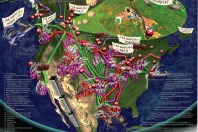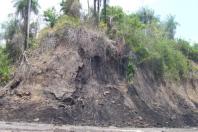The Wilderness Society is celebrating with the Southern Utah Wilderness
Alliance over striking a deal with the conservative elements in the
state. Trading away half a million acres of land to the energy industry
for 1.5 million acres of wilderness seems good on paper, after all. And
after the Bundy Ranch fiasco in Nevada, rapprochement between the greens
and the far right seems like exactly what the country needs.
But not everybody is happy.
Local groups Utah Tar Sands Resistance and Peaceful Uprising are crying
foul. "This is very much a sell out," organizer Raphael Cordry told me
over the phone. "It's very disappointing. They're trading the lives of
the people of Utah and their health and wellbeing for some wilderness
area, and the area that they're trading is the place we've actually been
protecting."
"They've been calling it a sacrifice zone, and we knew this, so it's not
a surprise," Cordry told me.
The Wilderness Society is shy about discussing the impacts of what the
Wall Street Journal is calling "the Grand Bargain." To Wilderness
Society spokesperson Paul Spitler, "It's pretty refreshing to see a new
approach."
Plus ça change, plus c'est la meme chose.
"We have seen for the past twenty years that the Bureau of Land
Management and School and Institutional Trust Lands Administration have
been strategically swapping parcels of land that was originally checker
boarded, so they trade off and make that a contiguous stretch of land."
This spate of parcels is located in northeastern Utah at the Book
Cliffs. With fir trees, bears, turkeys, elk, and deer, the land is by no
means an empty wasteland. But that's precisely what the energy industry
intends to make it into with a tar sands operation that has been in the
works for more than twenty years.
Even Jimmy Carter invested in oil shale at the end of his term, but the
tar sands have been kept at bay through a mixture of timing, lawsuits,
and activist engagement amounting to direct action. The high oil prices
of recent years led to increased initiative to exploit the oil shale and
tar sands in the region.
The region is located at the headwaters of the Colorado River. Lying
eight thousand feet elevation, where the Green River and White River
feed into the Colorado, the land forms a crucial watershed locale for
the 30 million people who rely on the Colorado River for their drinking
water downstream.
As the drought-stricken states in the West, particularly Colorado and
California, have begun to clash over access to water, problems of
pollution are growing increasingly menacing.
In Alberta, where the 97,000 square kilometers of boreal forest
ecosystem has been leased to active tar sands mining, the people who
live downstream from the Athabasca River are getting cancer at extremely
high rates, along with the animals who rely on the fresh water systems
being destroyed by the extensive bitumen mining. Much of the vital
freshwater ecosystem has been reduced to what looks like a mixture of a
vast industrial mountaintop removal site and a molten parking lot.
In nearby Vernal, Utah, increased infant mortality rates have already
been documented in the region. The oil and gas drilling is leaking
methane, such that now the air pollution in the rural area is equivalent
to living in Los Angeles.
The light, noise, and water pollution next door to the sacrifice zone is
also already intense in the tar sands region of Utah, before the main
mining has even commenced.
"The wilderness areas will not be valuable if all the streams contain
carcinogens." Cordray told me. "When you're out in the middle of nowhere
you can hear every machine."
Illegal Permission
The land in the sacrifice zone on the Book Cliffs is the land of the Ute
people, and mining on their land is regulated by the EPA. The
corporations involved in the tar sands are moving forward with strip
mining the Ute's land without the EPA's proper permission. Instead, Utah
is illegally allowing the corporations to allow strip mining on Native
lands.
The Governor of Utah, an ultra-right climate denier, appoints the Utah
Department of Water Quality and the Department of Environmental Quality.
The Department of Water Quality issued a permit for strip mining the
Ute's lands without so much as a water discharge, claiming there is no
water on the land at all, despite an abundance of evidenced spring water.
The legislature of Utah is also stacked with climate deniers, and the
American Legislative Exchange Council (ALEC) hosted their convention in
the state in 2013 to improve efforts to transfer federal lands to
private businesses.
US Oil Sands, the Canadian company doing the tar sands mining, is
connected not only to ALEC, but to the euphemistically-named Institute
for Clean and Secure Energy (ICSE), which operate in the University of
Utah. The ICSE spends the money it gets from Chevron, among other energy
sources, in the laboratory to make it cheaper to turn oil shale into
gasoline.
Last year, Utah Tar Sands Resistance interrupted an annual confab at the
University with the BLM head at the podium, revealing the extent of
collusion occurring at the highest-level institutions in the region.
"The people involved will grind up every inch of the earth," Cordray
told me. "They don't care."
Party Politics
Salt Lake City is among the top cities with the worst air quality in the
US today, with Kennecott copper mine, among other industrial players,
choking the environment. State lands in Utah contain recently uncovered
leaking wells leading to health problems, and the regulators have a
tendency to look the other way.
"This is a party, and they don't want it to get spoiled. They want to
provide energy, and they ignore the health impacts."
It's not only the energy and mining industries chomping at the bit to
pass the Grand Bargain. The ultra-conservative ranchers, who along with
rejecting evolution also likely believe their cattle can chew on bitumen
like the cud of the earth, are ecstatic—a surprise, given the amount of
caterwauling they have made over the smallest partitions of wilderness
in the past (Moab in 1979 comes immediately to mind).
Among these wealthier landowners boosting the Grand Bargain is San Juan
County Commissioner, Phil Lyman, who obtained recent celebrity status
after leading an ATV ride through protected Native
archeological/traditional lands in the aftermath of the Bundy standoff.
Against the Violent Enemies of Democracy
Lyman is from the old guard that includes Bundy and the late Dick
Carver, former County Commissioner of Nevada's Nye County and staunch
Christian Identity believer who became famous for bulldozing an
unpermitted mining road through a national forest with an armed posse
calling itself the "Fourth of July Vigilantes" back in '94 at the
dawning of the militia movement.
This crew is connected not only to the patriot, and militia movements,
but the old John Birch Society and County Rights groups that came
together with Wise Use (and, incidentally, the Posse Comitatus and Klan
groups that converged with the Aryan Nations and Christian Identity
groups) to terrorize environmentalists and conservationists throughout
the late-1980s and 1990s.
According to David Helvarg in his important book, War Against the
Greens, the Wise Use movement, astroturfed by big industry, helped boost
the stature of white supremacist groups: "while they may have felt they
were controlling the agenda, by legitimizing and lending credibility to
the Far Right these industries helped create and expand political space
for the violent enemies of democracy."
Right now, a terrible battle is brewing over the fate of the West, with
a good amount of people funded and fueled by the Koch hatoraide wanting
to transfer all federal lands to state hands. The goal of the right-wing
populists of the Sagebrush Rebellion and Wise Use, whose legacy the
current astroturfed movement inherits, is ultimately full privatization.
Transferring federal lands to either oil-and-gas leases or directly into
state lands is remarkably close, if not a kind of recasting of that goal.
With the oil prices low right now, "the Grand Bargain" looks like a real
estate investment for oil companies speculating on prices. In other
words, it's a land grab, which is why the old guard of the Wise Use
movement and Sagebrush Rebellion is so excited to push the deal through
Congress, where it is likely to be presented later this spring.
But Cordry is optimistic. "Since 2005, Peaceful Uprising and Utah Tar
Sands Resistance and groups like them have staved off the tar sands,"
Cordray tells me. "Now that the prices have dropped, we're hoping to
push US Oil Sands into bankruptcy."
Utah Tar Sands Resistance will be holding a peaceful vigil to observe
what they are doing from May to October. Last year, 27 people were
arrested in the area as hundreds converged to hold a vigil. Go
to www.tarsandsresist.org/ to find out more about how you can get
involved in the struggle to protect the land, air, and water for future
generations.
http://www.truth-out.org/speakout/item/30084-wilderness-society-selling-...


